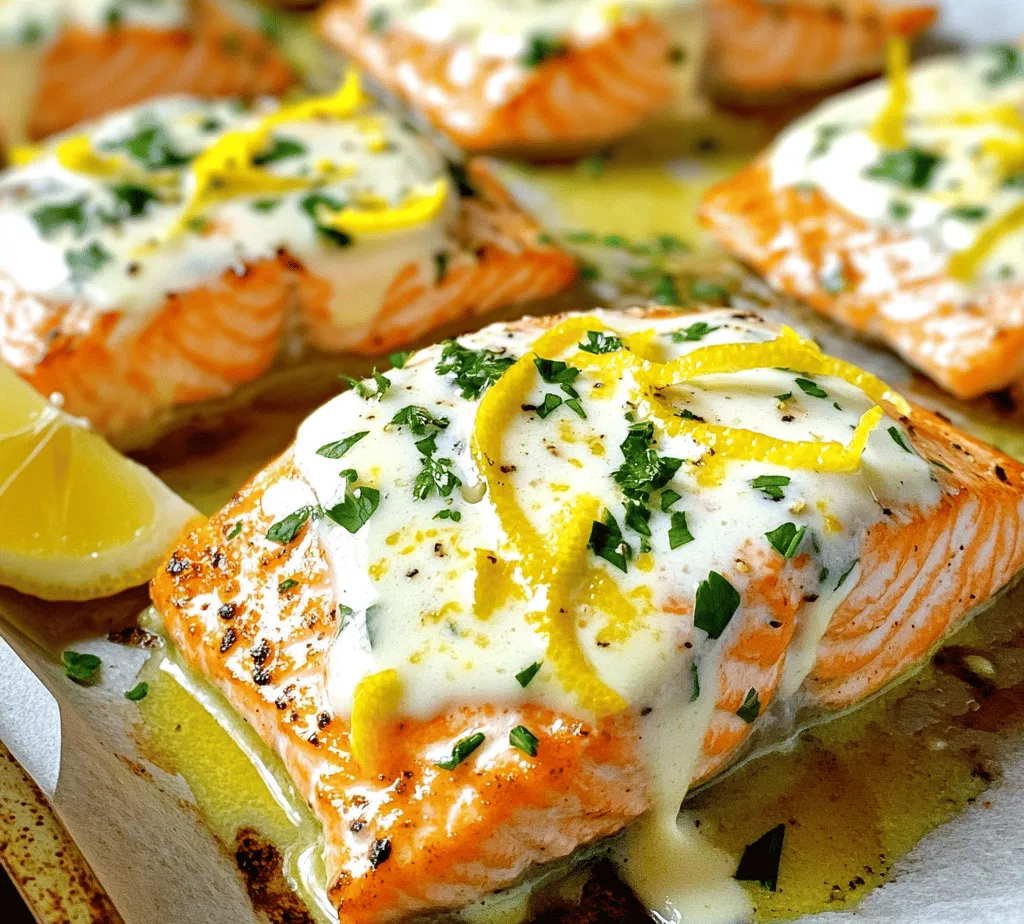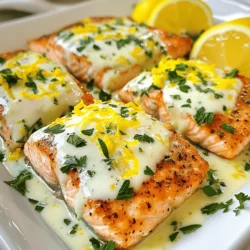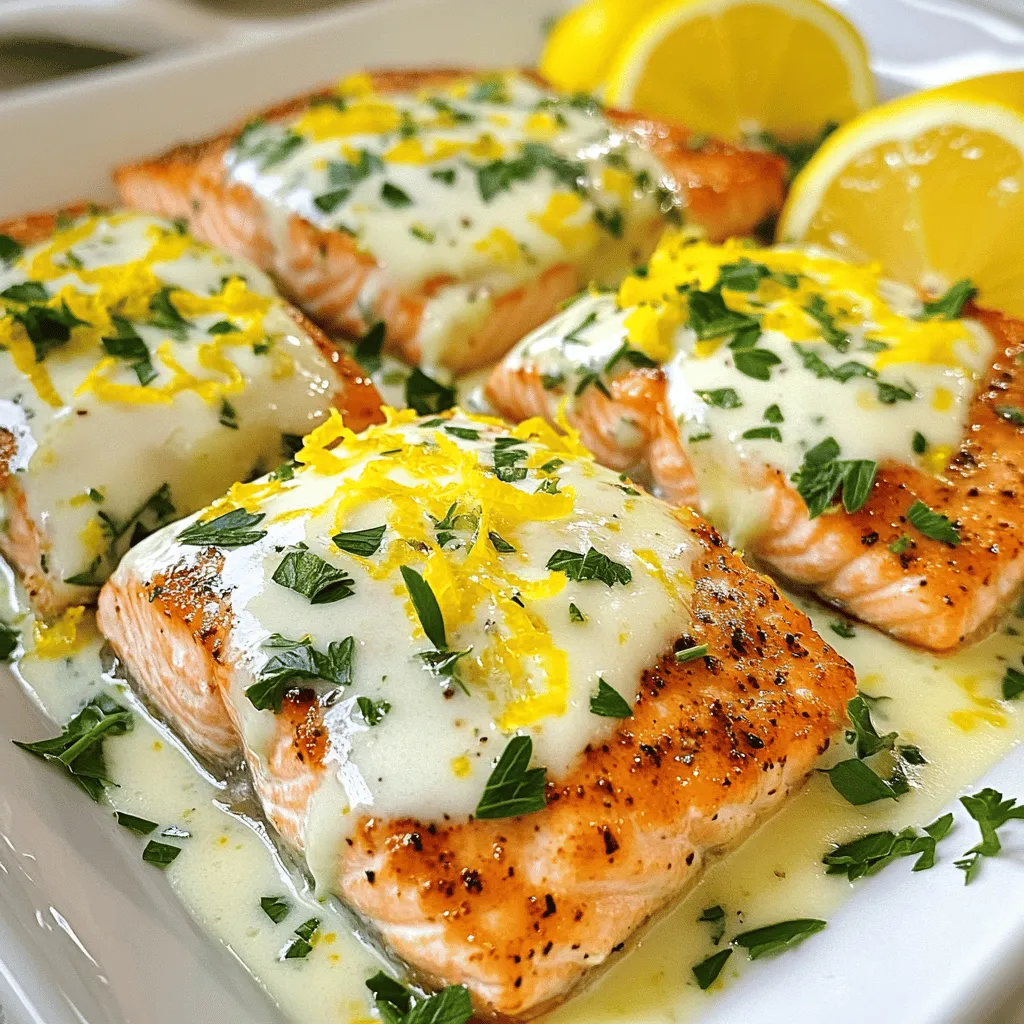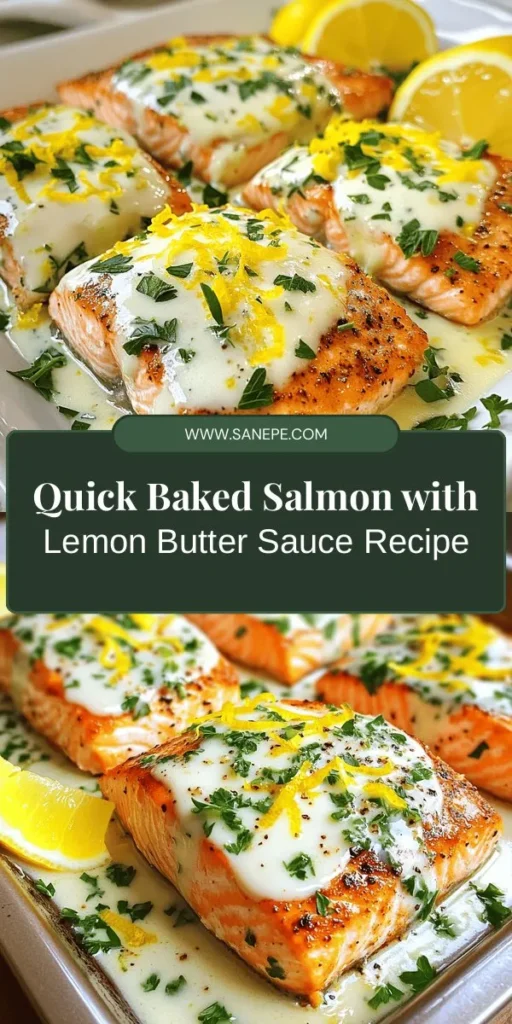Introduction
In the realm of culinary delights, few dishes can rival the simplicity and sophistication of baked salmon, especially when paired with a luscious lemon butter cream sauce. This dish not only tantalizes the taste buds but also embodies a perfect balance between health and flavor, making it an ideal choice for anyone looking to elevate their dinner game without spending hours in the kitchen. With its vibrant citrus notes and rich, creamy texture, this easy baked salmon recipe is a delicious way to satisfy your seafood cravings while also adhering to a healthy lifestyle.
In today’s fast-paced world, the demand for quick, nutritious meals has never been greater. Whether you’re a busy parent juggling work and family, a student on a tight schedule, or simply someone who prefers not to spend hours preparing dinner, this easy baked salmon recipe is designed for you. Ready in just 20 minutes, it delivers on both taste and convenience. Salmon is not only quick to cook but is also packed with essential nutrients, making it a fantastic choice for those who want to nourish their bodies without sacrificing flavor.
When it comes to flavor, this dish does not disappoint. The combination of tender salmon fillets with a creamy, zesty lemon butter sauce creates a delightful symphony of tastes that will impress even the most discerning palates. The richness of the butter is perfectly balanced by the brightness of the lemon, while the salmon itself offers a buttery texture and a subtle, savory flavor. Additionally, this dish boasts a variety of health benefits, including high levels of omega-3 fatty acids, which are known to support heart health, brain function, and overall well-being. It’s a win-win for both your taste buds and your health!
Understanding the Ingredients
Introduction to the Main Ingredients in the Recipe
To achieve the perfect baked salmon with lemon butter cream sauce, it’s essential to understand the key ingredients that come together to create this dish. The main players here include fresh salmon fillets, butter, heavy cream, fresh lemon juice, and a selection of herbs, such as parsley and dill, which add an aromatic touch.
Nutritional Benefits of Salmon
Salmon is often hailed as one of the healthiest fish available, and for good reason. Not only is it delicious, but it is also rich in high-quality protein, essential vitamins, and minerals. A single serving of salmon provides a substantial dose of omega-3 fatty acids, which are crucial for heart health and have been linked to reduced inflammation and improved brain function. Furthermore, salmon is an excellent source of B vitamins, particularly B12, which plays a vital role in energy production and maintaining a healthy nervous system. Incorporating salmon into your diet can significantly contribute to your overall health.
Role of Olive Oil in Cooking
In addition to salmon, olive oil is a key ingredient in this recipe. It serves multiple purposes: giving the salmon a beautiful, golden color while baking, enhancing its flavor, and providing additional health benefits. Extra virgin olive oil is particularly rich in antioxidants and healthy fats, making it a staple in heart-healthy diets. The use of olive oil not only adds a delicious depth to the dish but also makes it a healthier choice compared to other cooking fats.
Importance of Fresh Herbs and Citrus for Flavor Enhancement
The vibrant flavors of this dish are further enhanced by the use of fresh herbs and citrus. Fresh parsley and dill not only add a pop of color but also contribute aromatic qualities that elevate the overall taste of the salmon. The addition of fresh lemon juice brings a bright acidity that cuts through the richness of the butter, creating a well-balanced flavor profile that is both refreshing and satisfying. Using fresh herbs and citrus is essential for achieving that vibrant, restaurant-quality taste at home.
Preparing for Success: Equipment and Tools Needed
Essential Kitchen Tools for This Recipe
Before diving into the cooking process, it’s crucial to gather the necessary equipment to ensure a smooth and efficient preparation. For this easy baked salmon recipe, you will need:
1. Baking Sheet: A sturdy, rimmed baking sheet is essential for catching any drips from the salmon as it cooks. It also provides ample space for seasoning and arranging the fillets.
2. Parchment Paper or Aluminum Foil: Lining your baking sheet with parchment paper or aluminum foil can make cleanup a breeze and prevent the salmon from sticking.
3. Mixing Bowl: A medium-sized mixing bowl will be needed to combine the ingredients for the lemon butter cream sauce.
4. Whisk or Fork: You’ll need a whisk or fork to mix the sauce thoroughly and incorporate the flavors.
5. Meat Thermometer: While not strictly necessary, a meat thermometer can be a handy tool for ensuring your salmon is cooked perfectly. The FDA recommends that fish be cooked to an internal temperature of 145°F (63°C).
Recommendations for Baking Sheets and Cookware
When selecting a baking sheet, opt for one that is made of heavy-duty material to ensure even heat distribution. Non-stick or coated baking sheets are ideal, as they prevent the salmon from sticking and make for easier cleanup. If you prefer a more rustic look, using a cast iron skillet can also yield excellent results. The cast iron will help develop a beautiful sear on the salmon if you choose to start it on the stovetop before transferring it to the oven.
Importance of Using Quality Ingredients
The quality of your ingredients can significantly impact the final outcome of your dish. When selecting salmon, look for wild-caught options if possible, as they are generally considered to be more flavorful and sustainable compared to farmed varieties. Additionally, fresh herbs and high-quality butter and olive oil will enhance the overall taste and make your dish truly shine. Investing in quality ingredients is a crucial step in elevating your home cooking and ensuring that every bite is delicious.
Step-by-Step Guide to Making Baked Salmon
Preheating the Oven: The Importance of Temperature
To achieve perfectly baked salmon, preheating your oven is a critical first step. The ideal temperature for baking salmon is 400°F (200°C). This temperature allows the salmon to cook evenly while achieving a slightly crispy exterior. Preheating the oven ensures that the salmon is exposed to consistent heat from the moment it goes in, resulting in a tender and flaky texture.
Explanation of Why 400°F (200°C) is Ideal for Salmon
Baking salmon at 400°F strikes the right balance between cooking the fish thoroughly without drying it out. At this temperature, the salmon cooks quickly, typically in about 12-15 minutes, depending on the thickness of the fillets. This quick cooking time helps retain the fish’s moisture, ensuring a succulent final product. Additionally, the high heat allows for a nice caramelization on the outside, enhancing the overall flavor.
Preparing the Salmon Fillets
The next step involves preparing the salmon fillets for baking. Begin by rinsing the fillets under cold water and patting them dry with a paper towel. Removing excess moisture is important, as it helps the salmon achieve a nice sear and prevents it from steaming in the oven.
Detailed Instructions for Seasoning and Arranging on a Baking Sheet
Once the fillets are dry, place them on the lined baking sheet skin-side down. Season them generously with salt and pepper, which will enhance the natural flavors of the salmon. For added depth, drizzle a little olive oil over the fillets, ensuring they are evenly coated. If you’re feeling adventurous, consider adding minced garlic or a sprinkle of paprika for an extra layer of flavor.
For presentation, you can also arrange lemon slices around the salmon on the baking sheet. This not only looks appealing but also infuses the fish with additional citrus flavor as it bakes.
Tips for Choosing Fresh Salmon
When selecting salmon, freshness is key. Look for fillets that are bright in color and have a clean, ocean-like smell. Avoid any salmon with discoloration or a fishy odor, as these are signs of aging. If possible, purchase your salmon from a reputable fishmonger or market that specializes in fresh seafood to ensure you’re getting the best quality.
Baking Process
With the oven preheated and the salmon seasoned, it’s time to bake. Carefully place the baking sheet in the oven and set a timer for 12-15 minutes. The exact cooking time will depend on the thickness of your salmon fillets. As a general rule of thumb, a fillet should be baked for approximately 4-6 minutes per half-inch of thickness.
Signs to Look For to Ensure Salmon is Perfectly Cooked
To determine if your salmon is perfectly cooked, look for the following signs:
– Opaque Flesh: The salmon should appear opaque and firm to the touch. If it is still translucent or jiggly, it needs more time in the oven.
– Flakes Easily: Use a fork to gently flake the salmon at its thickest part. If it flakes easily and separates into sections, it is ready to be taken out of the oven.
– Internal Temperature: If you are using a meat thermometer, check that the internal temperature has reached 145°F (63°C). This ensures that the salmon is safe to eat and perfectly cooked.
Explanation of the Cooking Time and Its Significance
Cooking salmon for the right amount of time is crucial for achieving the desired texture. Overcooked salmon can become dry and tough, while undercooked salmon may be unsafe to eat. By closely monitoring the cooking time and checking for the signs mentioned above, you can ensure that your salmon is perfectly baked, juicy, and flavorful.
Stay tuned for Part 2, where we will delve into creating the lemon butter cream sauce, additional tips for achieving the best results, and answers to common questions about this delightful dish.

Making the Lemon Butter Cream Sauce
Creating the Lemon Butter Cream Sauce is a crucial step in bringing out the vibrant flavors of the baked salmon. This sauce is creamy, tangy, and complements the fish beautifully, enhancing the entire dish. Here’s a breakdown of the ingredients and their roles in crafting this delectable sauce.
Ingredients Breakdown
To make the Lemon Butter Cream Sauce, you will need the following ingredients:
– Unsalted Butter: Adds richness and a smooth texture to the sauce. It also helps to carry the flavors of the other ingredients.
– Garlic: Provides aromatic depth and a savory note. Fresh garlic is preferred for the best flavor.
– Heavy Cream: This is the base of the sauce, giving it a luxurious and creamy consistency, making the sauce indulgent.
– Lemon Juice: Offers acidity that brightens the sauce and balances the richness of the butter and cream.
– Lemon Zest: Intensifies the lemon flavor and adds a fragrant touch.
– Salt and Pepper: Essential for seasoning, these enhance the overall flavor of the sauce.
Role of Each Ingredient in the Sauce
– Unsalted Butter serves as the primary fat that emulsifies with the cream, creating a luscious texture.
– Garlic is sautéed to release its oils, providing a robust flavor that underpins the sauce.
– Heavy Cream contributes to the thickness and silky mouthfeel, making every bite delightful.
– Lemon Juice and Zest introduce a refreshing acidity that cuts through the richness, ensuring the sauce is well-balanced.
– Salt and Pepper are crucial for elevating the taste; they bring out the flavors of the butter and lemon.
Sautéing Garlic: Techniques for Perfect Flavor
Sautéing garlic correctly is critical to achieving the right flavor profile. Start by mincing the garlic finely to ensure it cooks evenly. Use medium heat to avoid burning, which can turn garlic bitter.
1. Heat the Butter: In a medium saucepan, melt the unsalted butter over medium heat. Allow it to foam slightly, which indicates it’s hot enough.
2. Add the Garlic: Once the butter is bubbling, add the minced garlic. Sauté for about 30 seconds, stirring constantly. You want the garlic to become fragrant and lightly golden, not brown.
Tips on Achieving the Right Level of Fragrance Without Burning
To avoid burning the garlic, keep a close eye on it and stir continuously. If you notice it starting to brown too quickly, reduce the heat slightly. The goal is to release the aromatic oils without compromising the flavor. Remember, the garlic will continue to cook slightly after you remove it from the heat, so take it off the burner just as it turns golden.
Creamy Consistency: Cooking Techniques
Achieving the right thickness for the Lemon Butter Cream Sauce involves a few simple techniques:
1. Incorporate the Cream: Once the garlic is sautéed, gradually stir in the heavy cream. Increase the heat slightly to bring the mixture to a simmer.
2. Simmer Gently: Allow the sauce to simmer gently for about 3-5 minutes. This helps to thicken the cream and meld the flavors. Stir occasionally to prevent it from sticking to the bottom of the pan.
How to Achieve the Right Thickness for the Sauce
For a thicker sauce, you can allow it to simmer longer, but be cautious not to let it boil vigorously. If you find the sauce is still too thin for your liking, you can create a slurry with a teaspoon of cornstarch mixed with cold water and add it to the simmering sauce to thicken it further.
Importance of Simmering and the Role of Acidity from Lemon Juice
Simmering is essential not only for thickening but also for concentrating flavors. After your sauce has reached the desired consistency, remove it from the heat and add the fresh lemon juice and zest. The acidity from the lemon juice brightens the sauce and prevents it from feeling overly heavy, while the zest enhances the citrus aroma. Taste and adjust the seasoning with salt and pepper for a well-rounded flavor.
Plating and Presentation
Once your baked salmon is ready and the Lemon Butter Cream Sauce is prepared, it’s time to plate the dish beautifully.
Best Practices for Serving Salmon Beautifully
1. Choose the Right Plate: Use a wide, shallow plate to allow for ample space and to showcase the salmon and sauce.
2. Position the Salmon: Place the salmon fillet in the center of the plate, slightly tilted for a dynamic look.
3. Drizzle the Sauce: Generously drizzle the Lemon Butter Cream Sauce over the salmon, allowing some to pool around the fish for an appealing presentation.
Garnishing with Parsley and Lemon Wedges for Visual Appeal
To elevate the presentation, garnish the dish with fresh chopped parsley for a pop of color. Adding lemon wedges on the side not only enhances the visual appeal but also offers a fresh squeeze of lemon for those who enjoy a bit more acidity.
Suggestions for Side Dishes That Complement the Meal
Pairing your baked salmon with complementary side dishes enhances the dining experience. Consider serving:
– Garlic Mashed Potatoes: Creamy potatoes will absorb the sauce wonderfully.
– Steamed Asparagus: A light and nutritious side that adds crunch and color.
– Quinoa Salad: A refreshing salad with cucumbers, tomatoes, and lemon vinaigrette provides a healthy contrast.
– Roasted Vegetables: Seasonal veggies like zucchini and bell peppers offer a sweet and savory balance to the dish.
Nutritional Value of Baked Salmon with Lemon Butter Cream Sauce
Baked salmon with Lemon Butter Cream Sauce is not only delicious but also packed with nutritional benefits.
Overview of Calories, Protein, and Healthy Fats in the Dish
A typical serving of this dish contains approximately:
– Calories: 450-500, depending on the serving size and ingredients used.
– Protein: About 35-40 grams, making it an excellent source of protein.
– Healthy Fats: Rich in omega-3 fatty acids, promoting heart health.
Health Benefits of Consuming Salmon Regularly
Salmon is known for its numerous health benefits, including:
– Heart Health: Omega-3 fatty acids help lower blood pressure and reduce inflammation.
– Brain Function: Regular consumption of salmon may support cognitive function and reduce the risk of age-related cognitive decline.
– Vitamin D: Salmon is a great source of Vitamin D, essential for bone health and immune function.
Discussion on the Balance Between Indulgence and Nutrition
While the Lemon Butter Cream Sauce adds richness to the dish, it is balanced by the lean protein and healthy fats found in salmon. Enjoying this meal provides a satisfying culinary experience without compromising on nutrition. It’s about finding a balance that allows for indulgence while still prioritizing health.
Variations and Customizations
This baked salmon recipe is versatile, allowing for various adaptations based on personal preferences and dietary needs.
Suggestions for Alternative Ingredients
– Herbs: Swap out parsley for dill or chives for a different flavor profile.
– Lighter Sauce: Consider using half-and-half instead of heavy cream for a lighter version of the sauce.
– Additional Flavors: Incorporate capers or Dijon mustard into the sauce for added complexity.
Creative Ways to Incorporate Seasonal Vegetables
Incorporating seasonal vegetables not only enhances the dish but also adds color and nutrition. Try roasting or sautéing:
– Spinach: Wilted spinach pairs beautifully with salmon.
– Cherry Tomatoes: Roasted tomatoes add a sweet burst of flavor.
– Broccolini: This tender vegetable complements the richness of the salmon and sauce.
Adapting the Recipe for Different Diets
For those with dietary restrictions, this recipe can easily be adapted:
– Dairy-Free Options: Use coconut cream or cashew cream as a substitute for heavy cream to maintain the sauce’s creaminess.
– Gluten-Free: This recipe is naturally gluten-free, making it suitable for those with gluten sensitivities.
Conclusion
In just 20 minutes, you can create a restaurant-quality dish with this Easy Baked Salmon with Lemon Butter Cream Sauce. The combination of tender salmon, a rich and tangy sauce, and beautiful presentation makes this meal a standout choice for any occasion.
We encourage you to try this recipe and enjoy the delightful flavors while benefiting from the nutritious qualities of salmon. Quick, nutritious meals are essential in today’s fast-paced lifestyle, and this dish exemplifies how easy it can be to prepare something healthy and satisfying without spending hours in the kitchen. Enjoy your culinary adventure, and don’t forget to share your experiences with others!


